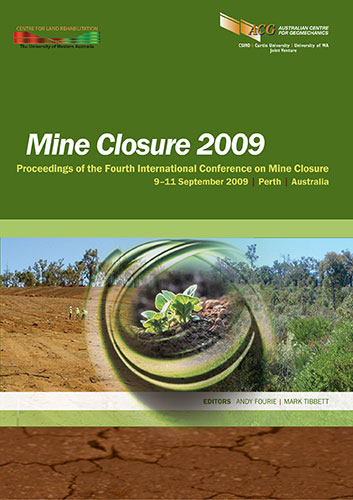Building the business case for closure

|
Authors: Finucane, S; Pershke, D |
DOI https://doi.org/10.36487/ACG_repo/908_10
Cite As:
Finucane, S & Pershke, D 2009, 'Building the business case for closure', in AB Fourie & M Tibbett (eds), Mine Closure 2009: Proceedings of the Fourth International Conference on Mine Closure, Australian Centre for Geomechanics, Perth, pp. 157-165, https://doi.org/10.36487/ACG_repo/908_10
Abstract:
A business case provides the framework for the planning and management of an entire project, and assists in systematically assessing the strengths and weaknesses of a project proposal. It includes justification for undertaking the project based on its anticipated risks, expected benefits and estimated costs. Business cases are used to assist in decision making processes, obtain management commitment and gain investment approval by providing sound rationale for the investment. A business case should address all phases of a project including closure; to do otherwise risks making a poor project investment. The need for mine closure to be an integrated part of the complete project life cycle, including business planning, is well documented. However, the information required by mining companies and project managers, and the tools that can be used to develop the business case for closure, are less well understood. Consequently, many industry personnel experience difficulty in developing an effective business case for closure. To provide guidance on how to successfully integrate mine closure planning and valuation into the business planning process, this paper draws on experience in the mining industry in Australia and Asia from the perspective of mining companies. This paper does not attempt to list all of the requirements for building a successful business case for closure, but discusses six key aspects in this regard: motivation, project design, risk assessment, legal compliance, closure valuation and teaming.
References:
BHP Billiton (2004) Closure Standard, Issue 1.0, July 2004, 23 p., viewed 9 May 2009,
osureStandard.pdf.
Department of Industry, Tourism and Resources (DITR) (2006) Mine Closure and Completion, Commonwealth
Government of Australia, 63 p.
Dowd, P. and Slight, M. (2006) The business case for effective mine closure, In Proceedings of the First International
Seminar on Mine Closure, Mine Closure 2006, A.B. Fourie, M. Tibbett (eds), 13–15 September 2006, Perth,
Australia, Australian Centre for Geomechanics, Perth, pp. 3–11.
International Council on Mining and Metals (ICMM) (2008) Planning for Integrated Mine Closure: Toolkit, London,
84 p.
Laurence, D.C. (2002) Optimising mine closure outcomes for the community – lessons learned, Minerals and Energy
Raw Materials Group 17, pp. 27–34.
Rio Tinto (2004) Rio Tinto Closure Standard, Version 2.0, June 2004, 9 p., viewed 9 May 2009,
Sutton, M., Pretorius, H., Nel, H., Julyan, F. and Rex, H. (2008) Closure planning and estimating with the Southern
Africa division of a global gold miner, In Proceedings of the Third International Seminar on Mine Closure, Mine
Closure 2008, A.B. Fourie, M. Tibbett, I.M. Weiersbye, P. Dye (eds), 14–17 October 2008, Johannesburg, South
Africa, Australian Centre for Geomechanics, Perth, pp. 145–159.
World Bank and International Finance Corporation (2002) It’s Not Over When It’s Over: Mine Closure Around the
World, International Finance Corporation, Washington DC, USA, 19 p.
© Copyright 2025, Australian Centre for Geomechanics (ACG), The University of Western Australia. All rights reserved.
View copyright/legal information
Please direct any queries or error reports to repository-acg@uwa.edu.au
View copyright/legal information
Please direct any queries or error reports to repository-acg@uwa.edu.au